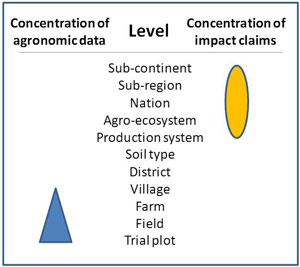We can think of both agronomic research results and impact claims as being distributed along a continuum of levels: in Africa, for example, from the level of the trial plot to that of the sub-continent (see picture).
 The foundational level at which applied agronomists work is the trial plot. Whether these trial plots are located on experiment stations or in farmers’ fields, work at this level characterises much agronomic research. Relatively few agronomists work at the field and farm levels, often by combining an element of modelling with their experimental activities, and all too rarely by working in close collaboration with social scientists. Agronomists have a long tradition of using experimental design, and repeating similar experiments over different locations, seasons and years in order to make their findings more robust and to increase the level at which they can be applied.
The foundational level at which applied agronomists work is the trial plot. Whether these trial plots are located on experiment stations or in farmers’ fields, work at this level characterises much agronomic research. Relatively few agronomists work at the field and farm levels, often by combining an element of modelling with their experimental activities, and all too rarely by working in close collaboration with social scientists. Agronomists have a long tradition of using experimental design, and repeating similar experiments over different locations, seasons and years in order to make their findings more robust and to increase the level at which they can be applied.
In contrast, in order to be taken seriously, a response to the pressure to demonstrate success and impact must be made at levels considerably higher than the trial plot, field or farm. A recent paper by Kassam and Brammer illustrates how claims for the System of Rice Intensification (SRI) and Conservation Agriculture (CA) are being made at these higher levels:
“…in the coming decades, both CA and SRI appear to offer the best hope of increasing food production rapidly, at low cost and without adverse environmental consequences in developing countries where human populations are increasing most rapidly. CA principles can strengthen the sustainability and productivity of most tillage systems (including ‘organic’ systems) in arable farming, horticulture, plantation agriculture, agro-forestry and integrated crop–livestock systems.”
Here, the claims about both CA and SRI are made at the level of “developing countries where human populations are increasing most rapidly”. For CA, they’re made at the level of “most tillage systems […] in arable farming, horticulture, plantation agriculture, agro-forestry and integrated crop–livestock systems”.
These are high level claims by any stretch of the imagination; and Kassam and Brammer are not the only ones making them. The question that deserves our attention is: How are such claims constructed; and can (how can) they ever be refuted?

We might think of such a high level claim as being like a large brick edifice. One way of constructing it would be brick-by-brick, where each new brick represents an additional piece of evidence. In the case of agricultural technologies such as SRI and CA, this additional evidence might expand the array of soil types, rainfall regimes, production systems, and so on, in which these technologies have been shown to both yield significant benefits and be practicable.
A high level claim constructed in this way would arise from, and would link directly to, a base of experimental or observational data that could be made available to be re-interrogated as required.
However, high level claims of the potential impact or success of agricultural technologies are seldom constructed in this way – primarily because the additional experimentation would simply be too time consuming and expensive. Funders don’t want to pay for that intensity of research, and everyone is under pressure to demonstrate results quickly.

So, rather than building a claim to ‘impact at scale’ by adding one brick of evidence to another, what appears to happen is that a very limited quantity of site-specific data is ‘stretched’: this allows the creation of a large but paper thin edifice that, to the eye of someone who is ready to believe, appears solid and robust.
The problem is that once such a large-scale claim has been established, despite having little real substance, it can be extraordinarily resistant to attack on the basis of argument and evidence.
This is partly because of the level at which the claims are made. As such claims is are not rooted in the world of evidence and are made in such general and universal terms, any critique based on the low-level counter-evidence of the agronomist (i.e. from trial plots, fields and farms) is repelled like water off a duck’s back. Emery Roe has made a similar observation in relation to the staying power of some development narratives, despite the existence of a significant body of undermining evidence.
This situation, where impact claims are largely divorced from the experimental evidence that is the life-blood of applied agronomy, and where mainstream academic journals increasingly allow themselves to be part of the process of ‘stretching’, represents a fundamental challenge to the discipline.
How agronomists respond to this challenge will, to a large extent, determine their relevance to sustainable agricultural development over the coming decades. We very soon need to see the green shoots of an agronomy fight-back!
References
- Kassam, A., & Brammer, H. (2012). Combining sustainable agricultural production with economic and environmental benefits. The Geographical Journal, no-no. doi: 10.1111/j.1475-4959.2012.00465.x
- Roe, E. M. (1991). Development narratives, or making the best of blueprint development. World Development, 19(4), 287-300.
- Sumberg, J., Irving, R., Adams, E., & Thompson, J. (2012). Success making and success stories: agronomic research in the spotlight. In J. Sumberg & J. Thompson (Eds.), Contested Agronomy: Agricultural Research in a Changing World. London: Routledge.
- Sumberg, J., & Thompson, J. (Eds.). (2012). Contested Agronomy: Agricultural Research in a Changing World. London: Routledge.
- Sumberg, J., Thompson, J., & Woodhouse, P. (2012). Why agronomy in the developing world has become contentious. Agriculture and Human Values, 1-13. doi: 10.1007/s10460-012-9376-8
Images:
- success rice, from nauright’s photostream on Flickr
- Flat Facade and GWTW Railroad Depot, from retroweb.com
- Talking to a Brick Wall, from joriel’s photostream on Flickr (by-nc-nd)
